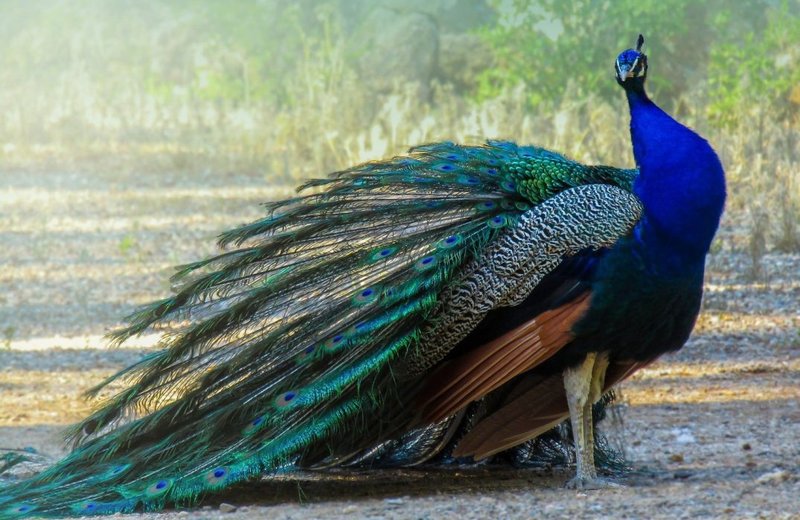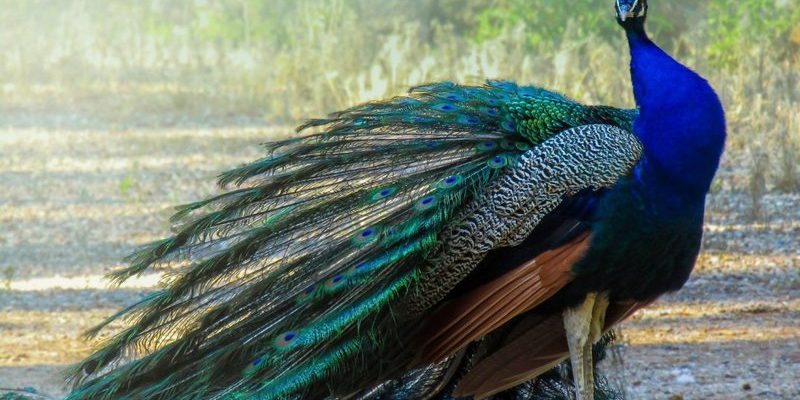
When people think of peacocks, many envision the Indian peafowl, the most recognized type with its stunning iridescent blue and green tail feathers. However, there are actually other species, like the green peafowl and the lesser-known African peafowl, each found in different corners of the world. Let’s unravel the mystery of where you can go to marvel at these magnificent birds, exploring their habitats across the globe like a treasure map leading you to vibrant destinations.
1. The Indian Peafowl: A Cultural Icon
You might already know that the Indian peafowl is synonymous with India itself. These birds are often seen adorned in temples and parks, embodying the rich cultural heritage of the country. They thrive in a variety of environments, from tropical rainforests to open grasslands.
In India, they prefer areas with plenty of cover—think small clusters of trees and bushes near water sources, which provide both protection and access to food. This means that if you’re journeying through rural areas or even national parks like Ranthambore or Bandhavgarh, you might just catch a glimpse of these beauties strutting their stuff. They often become part of local festivals too, reflecting their importance in Indian culture and folklore.
Interestingly, peafowl are also found in regions outside of India due to their adaptability. They’ve been introduced in places like the United States and parts of Europe, where they often roam freely in parks or gardens, adding an exotic touch to otherwise ordinary landscapes. Spotting them in these unexpected locations can feel like a delightful surprise!
2. Green Peafowl: The Lesser-Known Cousin
Let’s talk about the green peafowl, a stunning cousin to the Indian peafowl. These birds are primarily found in Southeast Asia, particularly in countries like Myanmar, Thailand, and Vietnam. Their habitat preferences lean towards more dense forests and wetlands, which means they thrive in places that provide both shelter and abundant food options.
In contrast to the Indian peafowl’s wide distribution, the green peafowl is a bit more elusive. They can often be found near rivers or swamps, where they forage for seeds, fruits, and small insects. If you’re planning a visit to national parks such as Khao Yai in Thailand or the Kakadu National Park in Australia, keep your eyes peeled—these areas offer great chances to witness the green peafowl in its natural glory.
Honestly, spotting a green peafowl can feel like an adventure. Their feathers, a brilliant mix of emerald and gold, blend beautifully into the foliage, making them a challenge to see. But when you do, it’s as if you’ve stumbled upon a secret treasure that the jungle has kept hidden.
3. African Peafowl: The Original
You might be surprised to learn there’s an African peafowl, often less recognized than its Asian relatives. This species is native to the African continent, primarily found in savannas, wooded regions, and even near farms. The African peafowl has a striking appearance, characterized by a more subdued color palette compared to its Indian counterparts but still exudes a certain charm.
Places like the Kruger National Park in South Africa or the Zambezi National Park in Zimbabwe are excellent locations to spot these birds. They are social creatures, often found in small groups foraging for food. Their diet mainly consists of seeds, insects, and small mammals, making them an interesting part of the local ecosystem.
If you’re in Africa, take some time to look for the African peafowl—it can be an exciting addition to your wildlife-viewing adventures. Watching them wander through the grasslands reminds us of the varied and spectacular life that thrives on this continent.
4. Urban Settings: Peafowl in Cities
Believe it or not, peafowl have made their homes in urban settings too! You might be wondering how these wild birds adapt to city life. It turns out that areas with parks, gardens, and historic estates can provide suitable environments for peafowl to thrive.
Cities like Los Angeles and San Francisco in the United States have neighborhoods where peafowl roam freely, often drawing in curious onlookers. Their vibrant colors create a stunning contrast against the backdrop of city structures. It’s a perfect example of how wildlife adapts and coexists with humans, bringing a splash of nature into our daily lives.
If you’re strolling through a city park and hear that iconic call, follow the sound! You may just find yourself face-to-face with a peacock, adding a touch of unexpected beauty to your urban adventure.
5. Where to Spot Them: National Parks and Reserves
National parks and wildlife reserves are undoubtedly the best places to spot peafowl in their natural habitats. These protected areas offer the ideal conditions for peafowl to flourish, surrounded by the food sources and space they need.
Some top recommendations include:
- Ranthambore National Park, India: Known for its rich biodiversity, you can spot Indian peafowl along with majestic tigers!
- Khao Yai National Park, Thailand: Explore lush forests, where you might find the elusive green peafowl.
- Kruger National Park, South Africa: With its vast landscapes, this park is perfect for viewing the African peafowl.
- Kakadu National Park, Australia: A unique spot where you can see the green peafowl amidst stunning scenery.
Visiting these parks not only gives you a chance to see peafowl but also lets you experience the rich ecosystems they inhabit. It’s a reminder of the importance of conservation and the beauty of nature surrounding us. Don’t forget your camera; you’ll want to capture those colorful plumages in action!
6. The Role of Peafowl in Ecosystems
Peafowl do more than just dazzle us with their beauty—they also play an important role in their ecosystems. By foraging for seeds and insects, they help maintain plant diversity and support the local food chain.
Here’s the thing: their presence can indicate a healthy ecosystem. When you spot a peafowl, it often means there’s a balance of flora and fauna that supports various wildlife. This interdependence is crucial for maintaining ecological harmony.
In areas where peafowl thrive, you might notice other wildlife flourishing as well. It’s a beautiful dance of life that underscores the importance of protecting these habitats, ensuring that future generations can continue to enjoy the sight of these magnificent birds.
7. Conservation Efforts and Challenges
Despite their adaptability, peafowl face challenges due to habitat loss and climate change. Conservation efforts are essential to protect their populations and the ecosystems they rely on. Organizations worldwide are working to preserve their natural habitats, ensuring these birds continue to grace our landscapes.
Here’s a thought: every time you visit a park or reserve, consider supporting conservation initiatives. Participating in eco-tourism not only enhances your travel experiences but also contributes to the preservation of the environments that house beautiful creatures like the peafowl.
Awareness and education are crucial, too. By understanding the importance of these birds and the challenges they face, we can all play our part in their conservation. Whether it’s sharing knowledge or advocating for sustainable practices, we can all contribute to ensuring peafowl thrive for generations.
In conclusion, if you’re eager to spot a peacock, you have plenty of options by exploring their diverse habitats across the globe. From the rural fields of India to the urban parks of America, these magnificent birds remind us that beauty can be found in both nature and unexpected places. So grab your binoculars, put on your walking shoes, and set out on your adventure to discover the amazing world of peafowl!

